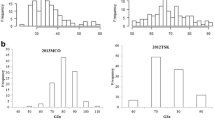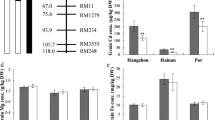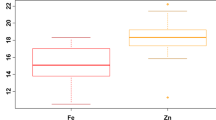Abstract
Optimizing the beneficial mineral elements in rice grains is of interest for rice breeders. To study the environmental effects on mineral accumulation in rice grains, we grew a double-haploid (DH) population derived from the cross between cultivars Chunjiang 06 (CJ06, a japonica rice) and TN1 (an indica rice) under two different ecological environments (Lingshui and Hangzhou, China) and determined the content of Ca, Fe, K, Mg, Mn, P, and Zn in brown rice. These contents show transgressive variation among the DH lines. Subsequently, the quantitative trait loci (QTLs) for mineral accumulation in rice grain were mapped on the chromosomes using CJ06/TN1 population. For the 7 mineral elements investigated, 23 and 9 QTLs were identified for Lingshui and Hangzhou, respectively. Of these, 24 QTLs were reported for the first time in this study and 8 QTLs are consistent with previous reports. Only 2 QTLs for Mg accumulation have been detected in both environments, indicating that mineral accumulation QTLs in rice grains are largely environment dependent. Additionally, co-localizations of QTLs for Mn and Zn, Mg and P, and Mg and Mn accumulation have been observed, implying that these loci might be involved in the accumulation of different elements. Furthermore, the QTLs for the accumulation of Fe, K, Mg, Mn, P, and Zn were mapped to a region close to each other on chromosomes 8 and 9, suggesting that clusters of genes exist on chromosomes 8 and 9. Further characterization of these QTLs will provide a better understanding of the molecular mechanism responsible for mineral accumulation in rice grains.


Similar content being viewed by others
References
Arnold, J. M., & Bauman, L. F. (1976). Inheritance of and interrelationships among maize kernel traits and elemental contents. Crop Science, 16, 439–440.
Arnold, J. M., Bauman, L. F., & Aycock, H. S. (1977). Interrelations among protein, lysine, oil, certain mineral element concentrations, and physical kernel characteristics in two maize populations. Crop Science, 17, 421–425.
Balint, A. F., Kovacs, G., Erdei, L., & Sutka, J. (2001). Comparison of the Cu, Zn, Fe, Ca, and Mg contents of the grains of wild, ancient and cultivated wheat species. Cereal Research Communications, 29, 375–382.
Bänziger, M., & Long, J. (2000). The potential for increasing the iron and zinc density of maize through plant-breeding. Food and Nutrition Bulletin, 21, 397–400.
Cakmak, I., Ozkan, H., Braun, H. J., Welch, R. M., & Römheld, V. (2000). Zinc and iron concentrations in seeds of wild, primitive, and modern wheat. Food and Nutrition Bulletin, 21, 401–403.
Combs, G. F. (2001). Selenium in global food systems. British Journal of Nutrition, 85, 517–547.
Eckhardt, U., Mas Marques, A., & Buckhout, T. J. (2001). Two iron-regulated cation transporters from tomato complement metal uptake-deficient yeast mutants. Plant Molecular Biology, 45, 437–448.
Garcia-Oliveira, A. L., Tan, L. B., Fu, Y. C., & Sun, C. Q. (2008). Genetic identification of quantitative trait loci for contents of mineral nutrients in rice grain. Journal of Integrative Plant Biology, 51, 84–92.
Ghandilyan, A., Ilk, N., Hanhart, C., Mbengue, M., Barboza, L., Schat, H., et al. (2009). A strong effect of growth medium and organ type on the identification of QTLs for phytate and mineral concentrations in three Arabidopsis thaliana RIL populations. Journal of Experimental Botany, 60, 1409–1425.
Gregorio, G. B., Senadhira, D., Htut, H., & Graham, R. D. (2000). Breeding for trace mineral density in rice. Food and Nutrition Bulletin, 21, 382–386.
Kennedy, G., Nantel, G., & Shetty, P. (2003). The scourge of “hidden hunger”: Global dimensions of micronutrient deficiencies. Food Nutrition and Agriculture, 32, 8–16.
Korshunova, Y. O., Eide, D., Clark, W. G., Guerinot, M. L., & Pakrasi, H. B. (1999). The IRT1 protein from Arabidopsis thaliana is a metal transporter with a broad substrate range. Plant Molecular Biology, 40, 37–44.
Lott, J. N. A., & West, M. M. (2001). Elements present in mineral nutrient reserves in dry Arabidopsis thaliana seeds of wild type and pho1, pho2, and man1 mutants. Canadian Journal of Botany, 79, 1292–1296.
Lu, K. Y., Li, L. Z., Zheng, X. F., Zhang, Z. H., Mou, T. M., & Hu, Z. L. (2008). Quantitative trait loci controlling Cu, Ca, Zn, Mn and Fe content in rice grains. Journal of Genetics, 87, 305–310.
Ma, L. Y., Yang, C. D., Zeng, D. L., Cai, J., Li, X. M., Ji, Z. J., et al. (2009). Mapping QTLs for heading synchrony in a double haploid population of rice in two environments. Journal of Genetics and Genomics, 36, 297–304.
Monasterio, I., & Graham, R. D. (2000). Breeding for trace minerals in wheat. Food and Nutrition Bulletin, 21, 392–396.
Norton, G. J., Deacon, C. M., Xiong, L. Z., Huang, S. Y., Meharg, A. A., & Price, A. H. (2010). Genetic mapping of the rice ionome in leaves and grain: Identification of QTLs for 17 elements including arsenic, cadmium, iron and selenium. Plant and Soil, 329, 139–153.
Schaaf, G., Ludewig, U., Erenoglu, B. E., Mori, S., Kitahara, T., & von Wiren, N. (2004). ZmYS1 functions as a proton-coupled symporter for phytosiderophore- and nicotianamine-chelated metals. Journal of Biological Chemistry, 279, 9091–9096.
Shimizu, A., Guerta, C. Q., Gregorio, G. B., Kawasaki, S., & Ikehashi, H. (2005). QTLs for nutritional contents of rice seedlings (Oryza sativa L.) in solution cultures and its implication to tolerance to iron-toxicity. Plant and Soil, 275, 57–66.
Sogava, K., Qian, Q., Zeng, D. L., Hu, J., & Zeng, L. J. (2005). Differential expression of whitebacked planthopper resistance in the japonica/indica doubled haploid rice population under field evaluation and seedbox screening test. Rice Science, 12, 63–67.
Umeta, M., West, C. E., Haidar, J., Deurenberg, P., & Hautvast, J. G. A. J. (2000). Zinc supplementation and stunted infants in Ethiopia: A randomised controlled trial. Lancet, 355, 2021–2026.
Viteri, F. E., & Gonzalez, H. (2002). Adverse outcomes of poor micronutrient status in childhood and adolescence. Nutrition Reviews, 60, 77–83.
von Wire’n, N., Klair, S., Bansal, S., Briat, J. F., Khodr, H., Shioiri, T., et al. (1999). Nicotianamine chelates both FeIII and FeII. Implications for metal transport in plants. Plant Physiology, 119, 1107–1114.
Vreugdenhil, D., Aarts, M. G. M., Koornneef, M., Nelissen, H., & Ernst, W. H. O. (2004). Natural variation and QTL analysis for cationic mineral content in seeds of Arabidopsis thaliana. Plant, Cell and Environment, 27, 828–839.
White, P. J., & Broadley, M. R. (2005). Biofortifying crops with essential mineral elements. Trends in Plant Science, 10, 586–593.
Yang, C. D., Zeng, D. L., Ma, L. Y., Ji, Z. J., Guo, L. B., Li, X. M., et al. (2006). Mapping QTLs for bacterial blight resistance in a DH population from japonica/indica cross of rice (Oryza sativa). Chinese Journal of Rice and Science, 20, 102–104.
Zhang, M. W., Guo, B. J., & Peng, Z. M. (2004). Genetic effects on Fe, Zn, Mn and P contents in Indica black pericarp rice and their genetic correlations with grain characteristics. Euphytica, 135, 315–323.
Zhang, G. H., Zeng, D. L., Hu, S. K., Su, Y., Jia, L. T., Guo, L. B., et al. (2006). QTL analysis of traits concerned submergence tolerance at seedling stage in rice (Oryza sativa L.). Acta Agronomica Sinica, 32, 1280–1286.
Zhang, J., Zhu, Y. G., Zeng, D. L., Cheng, W. D., Qian, Q., & Duan, G. L. (2008). Mapping quantitative trait loci associated with arsenic accumulation in rice (Oryza sativa). New Phytologist, 177, 350–355.
Acknowledgments
This work was supported by the Ministry of Science and Technology of China (Grant No. 2011CB100304), National Nature Science Foundation of China (Grant No. 30821061) and HarvestPlus Challenge Program (Agreement #8236).
Author information
Authors and Affiliations
Corresponding author
Additional information
Juan Du and Dali Zeng contributed equally to this work.
Rights and permissions
About this article
Cite this article
Du, J., Zeng, D., Wang, B. et al. Environmental effects on mineral accumulation in rice grains and identification of ecological specific QTLs. Environ Geochem Health 35, 161–170 (2013). https://doi.org/10.1007/s10653-012-9473-z
Received:
Accepted:
Published:
Issue Date:
DOI: https://doi.org/10.1007/s10653-012-9473-z




